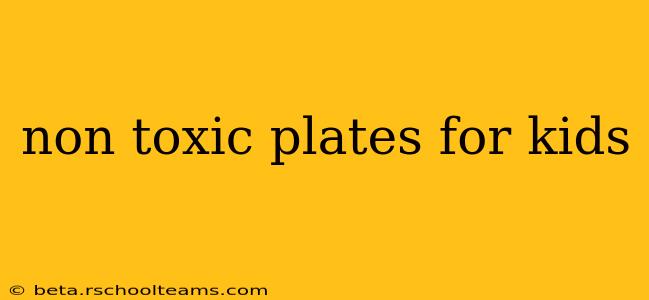Choosing the right dinnerware for your little ones can feel overwhelming. With so many options available, it's crucial to prioritize safety and health. This guide delves into the world of non-toxic plates for kids, helping you navigate the choices and make informed decisions for your family. We'll explore different materials, safety standards, and factors to consider when selecting the perfect plates for your child's meals.
What Makes a Plate "Non-Toxic"?
The term "non-toxic" refers to plates made without harmful chemicals or materials that could leach into food, especially when exposed to heat or acidic substances. This is particularly important for children, whose developing bodies are more susceptible to the effects of toxins. Key things to avoid include:
- BPA (Bisphenol A): A chemical used in some plastics that's linked to hormonal disruption.
- Phthalates: Chemicals used to make plastics more flexible, also associated with health concerns.
- Lead: A heavy metal that can cause developmental problems.
- Cadmium: Another heavy metal that can be toxic.
- PVC (Polyvinyl Chloride): A type of plastic that can release harmful chemicals when heated.
What are the Best Materials for Non-Toxic Kids' Plates?
Several materials offer safer alternatives to potentially toxic plastics. Here's a breakdown:
1. Stainless Steel:
- Pros: Durable, recyclable, resistant to stains and odors, naturally non-toxic.
- Cons: Can be heavy and prone to dents. May not be suitable for very young children who might drop them.
2. Bamboo:
- Pros: Sustainable, biodegradable, lightweight, often naturally antibacterial.
- Cons: Can be less durable than stainless steel or melamine, and may require more careful cleaning. Avoid soaking for extended periods.
3. Silicone:
- Pros: Flexible, lightweight, durable, dishwasher and microwave safe (check manufacturer specifications), non-toxic when made from food-grade silicone.
- Cons: Can be more expensive than other options. Some parents find the texture less appealing than other materials.
4. Melamine (with caution):
- Pros: Lightweight, durable, shatter-resistant, often inexpensive.
- Cons: Some melamine products contain harmful chemicals, so it’s crucial to choose only plates certified as BPA-free and made from high-quality materials. Always check for reputable brands and certifications.
5. Glass:
- Pros: Non-toxic, easy to clean, durable if not dropped.
- Cons: Heavier and more fragile than other options; not ideal for young children. Avoid glass plates for toddlers or very active children.
Are Non-Toxic Plates Really Necessary?
While the risks associated with exposure to toxins in dinnerware might seem minimal, the precautionary principle suggests it’s best to err on the side of caution, especially when it comes to children's health. Choosing non-toxic plates is a proactive step towards reducing your child's exposure to potentially harmful chemicals.
What to Look for When Buying Non-Toxic Plates
- Certifications: Look for certifications like BPA-free, FDA approved, or other relevant certifications from reputable organizations.
- Materials: Opt for materials known for their non-toxicity, as discussed above.
- Reviews: Read reviews from other parents to gauge the durability and practicality of different products.
- Brand Reputation: Choose reputable brands with a strong commitment to safety and quality.
How to Clean Non-Toxic Plates?
Cleaning instructions will vary depending on the material. Always follow the manufacturer's recommendations. Generally, most non-toxic plates are dishwasher safe, but hand washing is always an option.
What if my child's plate is chipped or broken?
Discard any plate with chips or cracks immediately to prevent the ingestion of small pieces or exposure to any potential chemicals inside the material.
Are all melamine plates toxic?
No. However, it is vital to choose melamine plates that are explicitly labeled BPA-free and from a reputable brand that adheres to safety standards. Always check product descriptions carefully before purchasing.
Are there any specific safety regulations for children's dinnerware?
Safety regulations for children's dinnerware vary by country and region. Check with your local authorities for specific guidelines and standards in your area. Look for certifications that indicate compliance with relevant safety standards.
By following these guidelines and focusing on reputable brands and safe materials, you can confidently select non-toxic plates that prioritize your child's health and well-being while ensuring enjoyable mealtimes.
